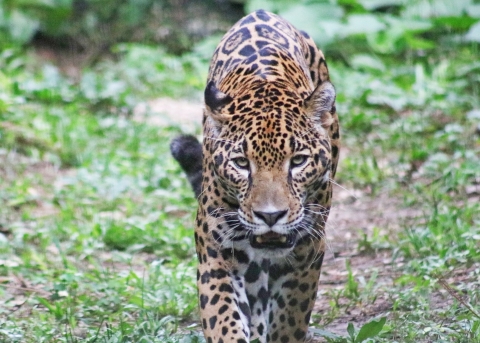House cats may rule the Internet Era, but few felines have the timeless cultural appeal of the jaguar. Revered in Mesoamerican and South American cultures for hundreds of years and a symbol for teams and brands today, jaguars have an enduring reputation for power and stealth.
It’s no wonder. The biggest cats in the Americas can weigh more than 300 pounds and measure up to eight feet from nose to tail. Jaguars also have the strongest bite of any cat in the Western Hemisphere and are the only ones on this side of the globe that can roar.
But most of the time, you’re not going to hear them roar — that’s because they’re silently stalking their prey from every possible angle.
They can hunt by night or day, climb trees, swim across rivers, run up to 50 mph, and, with black-spotted yellow coats that help them hide in the sun-dappled forest understory, they can also lie patiently in wait.
Their hunting prowess is also a natural asset. As top predators, they keep populations of other animals in check — including those that damage crops, like deer, and those that carry diseases that can be transmitted to people, like armadillos.
Talk about a healthy appetite.
Big cats, big challenges
Big cats like jaguars face big challenges. Unfortunately, the jaguar has lost nearly half of its historic range, which stretches from the southwestern U.S. to northern Argentina.
Large carnivores are particularly vulnerable to the loss and fragmentation of habitat because they need to roam over large areas to find and hunt prey. While jaguars can cross rivers with ease, major roads can be a dead end, bisecting forests and leading to collisions with vehicles.
When jaguars get hemmed into unnaturally small areas by deforestation or development, it’s bad both for jaguars and for local communities. Although jaguars would normally avoid areas where people live, with limited access to wild prey, they sometimes resort to hunting livestock. In return, they are hunted in retaliation by ranchers who see them as a threat.
Small, isolated jaguar populations are at risk from poaching and illegal trade, as are larger populations in nations with limited capacity to effectively combat poaching and trafficking. In Latin America, jaguar body parts — such as fangs, skins, skulls, bones, and fat — are sold illegally for cultural, decorative, medicinal, and other purposes.
Evidence suggests demand is growing for illegal jaguar products in other parts of the world too.
Working together to support a shared species
Habitat loss, conflict with communities, and poaching in retaliation or for the illegal wildlife trade are common challenges for jaguars wherever they’re found, but saving this shared species is also a common goal.
Since its listing as an endangered species, the protections of the Endangered Species Act have kept this cat from the brink and inspired innovative and collaborative conservation actions.
In the United States, with funding provided by the Department of Homeland Security to study border species, the U.S. Fish and Wildlife Service worked with the University of Arizona to implement a three-year jaguar study in mountain ranges in southern Arizona and New Mexico using motion-sensor field cameras.
Although that project ended in 2015, it evolved into a community science initiative that is still going strong today. The University of Arizona Wild Cat Research Center has trained more than 75 volunteers to monitor cameras, collect scat samples, and analyze data, resulting in documented sightings of jaguars as well as ocelots.
The funding also supported the creation of a public Jaguar Observation Database, a searchable catalog of jaguar sightings in northern Mexico and the United States, including from the University of Arizona study.
The path to recovery depends on international collaboration
In 2018, the U.S. Fish and Wildlife Service released a recovery plan for the jaguar that outlines specific recovery objectives and criteria to be met to enable us to remove this species from the list of endangered species.
Because the majority of the jaguar’s range is outside of the United States, and spans 19 countries, collaboration with partners in many places is key to conservation success.
That is why the Service supports work abroad through our Latin America Regional Program within International Affairs to move jaguars toward recovery while also benefiting local and Indigenous communities.
The jaguar is one of the priorities of the program, which focuses on species conservation and conservation stewardship. For example, the program promotes jaguar-friendly farming practices that are also good for farmers and implements innovative monitoring techniques that will help authorities respond to poaching incidents more efficiently and effectively.
How can you help jaguars?
You can play a role in jaguar conservation too. Here are a few ways to help:
- Learn more about “jaguar-friendly” certified coffee and beef. Growers and ranchers receive these certifications by managing their lands in a way that benefits jaguars, their habitat, and their prey.
- Buy informed, if you are considering purchasing products made from wildlife. Avoid jaguar skins and jewelry made from jaguar teeth and claws.
- Contribute to community science initiatives. If you live within the range of the jaguar, report sightings to your local conservation agency. There may be opportunities to volunteer for a community science initiative where you live.
Give jaguars a “break.” When driving, follow speed limits and drive with care, particularly in roads around key biodiversity hotspots, wildlife corridors, and natural protected areas.






